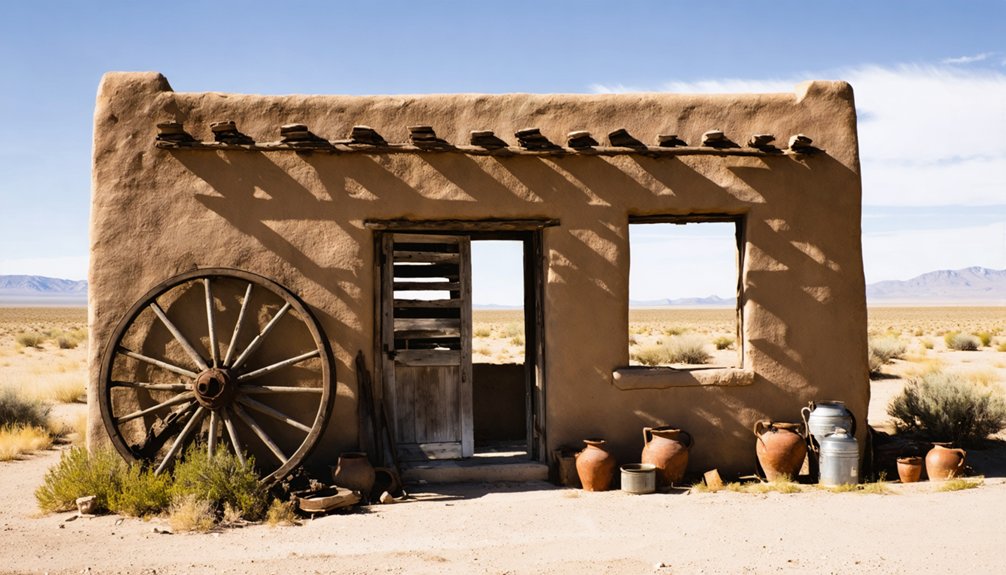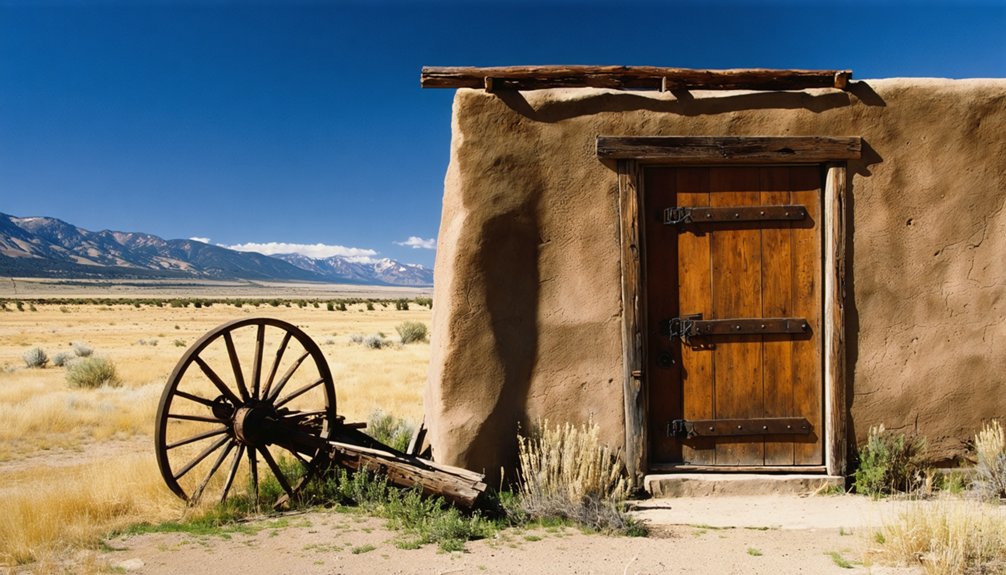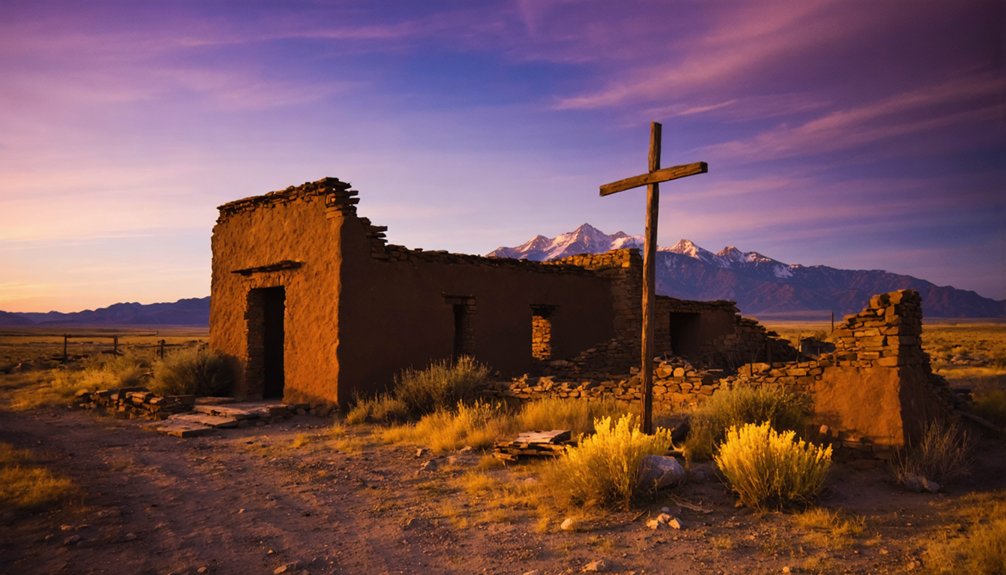You’ll find the ghost town of Autobees at the historic junction of the Cimarron Cutoff and Mountain Branch of the Santa Fe Trail. Charles Autobees established this essential trading post in 1848, building adobe fortifications and irrigation ditches that supported a thriving frontier community. The settlement flourished until the 1890s, serving as a hub for fur traders, merchants, and farmers. While the town’s physical structures have vanished, its rich multicultural legacy lives on through thousands of descendants.
Key Takeaways
- Autobees Trading Post, established in 1848 by Charles Autobees, served as a vital economic hub at the confluence of major trade routes.
- The settlement featured adobe fortifications, irrigation ditches, and a ferry service across the Arkansas River.
- Economic decline began when the railroad bypassed the town, severely impacting trade and transportation networks.
- Devastating floods destroyed crops and homes, forcing families to relocate to nearby Pueblo and other communities.
- The town’s final demise was marked by the closure of its post office in 1890.
The Rise of a Trading Post Along the Santa Fe Trail
Three key factors propelled Autobees Trading Post to prominence along the Santa Fe Trail: its strategic location, robust infrastructure, and essential economic role.
You’ll find this historical gem positioned perfectly at the confluence of the Cimarron Cutoff and Mountain Branch, where trading strategies flourished thanks to its proximity to critical river crossings and mountain passes.
The post’s adobe fortifications and irrigation ditches weren’t just practical – they represented the historical significance of frontier innovation. Charles Autobees supervised the construction of these impressive structures in 1848.
Adobe walls and water systems at Autobees stood as powerful symbols of human ingenuity on America’s untamed frontier.
Behind those high walls, you’d discover a bustling hub where fur traders exchanged wolf pelts, and merchants traded everything from Navajo blankets to firearms. Like many trading posts of the era, it faced constant threats from Kiowa warriors who frequently raided settlements along the trail.
The post’s stagecoach station and military presence made it an indispensable haven for travelers braving the dangerous journey across the Plains, transforming it into the lifeline of regional commerce.
Charles Autobees: Pioneer and Mountain Man
You’ll find Charles Autobees’s remarkable frontier story began in 1812 St. Louis, where his French-Canadian, First Nations, and Irish heritage shaped his future as a mountain man and trader.
His work with Simeon Turley in Taos and later experiences as a fur trader built the foundation for his pioneering ventures in what would become southern Colorado.
As the first non-Native American settler in present-day Pueblo County, Autobees established a thriving trading post that became an essential link between settlers and indigenous communities along the Arkansas River.
His life was marked by tragedy when his father drowned while logging, shaping his early childhood experiences and resilience.
His legacy lives on through tens of thousands of descendants who continue to shape Colorado’s identity and culture.
Early Life and Origins
Born into a culturally diverse family in St. Louis around 1812, Charles Autobees embodied the rich tapestry of America’s frontier heritage.
You’ll find his ancestry woven from multiple threads – a Delaware Indian mother, a French-Canadian father, and Irish roots that added to his unique cultural influences. His family name appeared in various forms, including Urtebise and Ortivis, reflecting the fluid nature of frontier identity. After his father drowned while logging, young Charles faced significant changes in his family dynamic.
As you explore his early years, you’ll discover how these mixed cultural influences shaped his future as a mountain man and pioneer. His early experiences would prepare him for his distinguished career as a military scout under Captain Ceran St. Vrain in 1847.
His Native American and European heritage gave him distinct advantages in bridging different worlds, preparing him for his later role in Western expansion and the settlement of southern Colorado.
Trading and Settlement Legacy
While many pioneers ventured west seeking fortune, Charles Autobees left an indelible mark on southern Colorado through his diverse roles as a mountain man, trader, and settler.
You’ll find his influence in the trading networks he established, from operating an essential ferry service across the Arkansas River to running a popular saloon near Fort Reynolds. His agricultural innovation brought the first irrigated crops to the Arkansas River valley, transforming the region’s potential. His early work as a notable mountain trapper alongside legends like Jim Bridger and Kit Carson prepared him for the challenges ahead. In 1853, he established a thriving colony near the junction of the Huerfano and Arkansas Rivers.
As one of Huerfano County’s first commissioners in 1861, he helped shape local governance while maintaining critical relationships with Native American tribes through trade and cultural understanding.
Though he eventually lost his land holdings, Autobees’ legacy lives on in Pueblo County’s landscape, where his name graces streets and historical markers, proof of his pioneering spirit.
Life at the Crossroads of Rivers
Standing at the convergence of the Huerfano and Arkansas Rivers, Autobees Plaza emerged in 1853 as a pivotal settlement that would shape the destiny of southern Colorado’s frontier.
You’d find the river ecosystems providing essential resources – fertile soil for farming, fresh water, and natural defense lines against threats. His knowledge of multiple tribal languages helped him mediate between settlers and local tribes. The crossroads location fostered rich cultural interactions, as traders, travelers, and diverse ethnic groups crossed paths at Charles Autobees’ settlement.
Here, French-Canadian, Irish, Mexican, and Native American influences blended through marriage, trade, and daily life. The community’s resilience showed in their response to challenges, from operating ferries across treacherous waters to defending against raids. The settlement thrived under Charles Autobees’ honest reputation as he managed mule trains and traded essential goods like flour and corn.
Life at this junction demanded grit, adaptability, and the ability to navigate both natural barriers and cultural boundaries.
Economic Growth and Development
As Charles Autobee laid the cornerstone of his frontier settlement in 1853, he established what would become an important economic hub at the confluence of major trade routes.
Despite economic challenges, the community’s resilience shone through their diverse business ventures:
Economic hardships could not dim the determined spirit of a community that found strength in its entrepreneurial diversity.
- Operating an essential ferry service across the Arkansas River for traders and settlers
- Running a bustling saloon near Fort Reynolds that served as a gathering spot
- Managing successful ranching and farming operations in fertile river bottoms
- Maintaining trading posts that connected U.S. territories with Mexico
- Serving as the county seat, bringing administrative importance to the area
The Autobee family’s mixed heritage and entrepreneurial spirit fostered a dynamic economy that bridged cultures and enabled regional growth.
Their leadership in trade, agriculture, and local governance helped create a stable foundation for southern Colorado’s development.
Cultural Heritage and Family Legacy

While you’ll find the Autobees family’s influence throughout modern Pueblo County, their cultural footprint began with Charles Autobees, who married Sycamore, an Arapaho woman, creating a unique blend of Mexican, Indigenous, and European traditions.
The family’s legacy lives on through tens of thousands of descendants who maintain strong community ties and preserve their rich heritage through the Autobee Club and regular family gatherings.
You can trace their continuing impact through local street names, memorials, and historical markers that honor both the pioneering ancestors and later family members like Staff Sgt. George M. Autobee, who gave his life at Normandy.
Pioneer Family’s Enduring Impact
Through multiple generations spanning over 160 years, the Autobees family has profoundly shaped southern Colorado’s cultural landscape.
Their pioneer influence extends far beyond Charles Autobees’ initial settlement in 1853, establishing a legacy of leadership and cultural bridge-building that you’ll still find woven into Pueblo County’s fabric today.
The family’s enduring impact is evident through:
- Colorado’s second-oldest lineage with thousands of descendants statewide
- Continuous military service tradition, including heroic sacrifices like Sgt. George M. Autobee in WWII
- Cross-cultural heritage blending Native American, Mexican, and European roots
- Active preservation of family traditions through the Autobee Club
- Visible presence in local landmarks, street names, and memorials throughout Pueblo
This multicultural pioneer family continues shaping community life through public service and cultural preservation.
Mexican Heritage Preservation
Deep within Pueblo’s cultural fabric, the Mexican heritage preservation efforts of the Autobee family stand as a symbol of southern Colorado’s rich multicultural roots.
You’ll find their legacy woven throughout the community’s heritage initiatives, from the Avondale Neighborhood Memory Project to the historical markers that dot the landscape. The St. Vrain Cemetery in Boone serves as a cultural cornerstone, while the Autobee Club actively champions family history and Mexican traditions.
Through oral histories, digitized archives, and community events, you’ll discover how cultural preservation remains vibrant among Autobee descendants.
They’ve maintained their connection to Mexican customs, language, and traditions through family gatherings and storytelling. Their influence has helped shape Pueblo into a thriving Mexican American cultural hub, where Spanish words and ancestral practices continue to enrich daily life.
Modern-Day Autobees Community
Today’s Autobee legacy thrives through the dedication of thousands of descendants who maintain their family’s pioneering spirit in southern Colorado.
You’ll find their impact throughout Pueblo County, where the Autobees community regularly gathers to honor their heritage through local gatherings, educational programs, and preservation efforts.
- Annual family reunions celebrate the region’s second-oldest family lineage
- The Autobee Club actively preserves photographs, artifacts, and family stories
- Veterans’ memorials in Avondale honor military service members like Staff Sgt. George M. Autobee
- Street signs and historical markers throughout Pueblo bear the family name
- St. Vrain Cemetery in Boone features a memorial marker for Charles Autobee
Despite never becoming a classic ghost town, Autobees Plaza’s historical significance lives on through its descendants’ unwavering commitment to their cultural heritage and community involvement.
The Final Days of a Frontier Settlement

As the sun set on Autobees in the late 1800s, this once-vibrant frontier settlement faced a perfect storm of challenges that would seal its fate.
The decline dynamics were relentless – the railroad bypassed the town, the river ferry business collapsed, and unpredictable floods destroyed crops and homes along the Huerfano River.
You’d have seen the community unravel as families packed up for Pueblo and other promising towns.
The schoolhouse fell silent, church bells stopped ringing, and the post office’s closure in 1890 signaled the end of an era.
Local businesses shuttered one by one, leaving only scattered ruins and memories.
Frequently Asked Questions
What Was the Population of Autobees at Its Peak?
You’ll find this ghost town’s peak population was likely 20-50 residents, though no official records exist. Its historical significance stems from being the first permanent settlement in today’s Pueblo County.
Are There Any Remaining Buildings or Structures From the Original Settlement?
Like footprints washed away by time, you won’t find any remaining structures from the original settlement. While its historical significance lives on through markers, the physical buildings haven’t survived.
What Happened to Charles Autobees’ Descendants After the Town’s Decline?
You’ll find many Autobees descendants still thriving in southern Colorado, especially around Pueblo and Huerfano County. They’ve preserved their family legacy through military service, civic leadership, and community involvement.
Was the Town Ever Officially Incorporated?
Like a mirage in the desert, you won’t find official incorporation papers. Historical records show Autobees remained an informal homestead settlement without town governance, never achieving formal municipal status under territorial law.
Did Any Notable Historical Events or Battles Occur in Autobees?
While you won’t find notable battles there, the town’s historical significance centers on Charles Autobees’ personal conflicts with Ute warriors and his pioneering role in settling Colorado’s untamed frontier.
References
- https://www.cbsnews.com/colorado/news/colorado-autobees-helped-shape-pueblos-rich-mexican-heritage/
- https://worldjournalnewspaper.com/huerfanos-first-citizen/
- https://www.legendsofamerica.com/charles-autobees/
- https://www.chieftain.com/story/lifestyle/2010/08/10/pueblo-pioneer-true-trailblazer/8713067007/
- https://www.youtube.com/watch?v=oX_0SGuFnfQ
- https://canyonsandplains.org/santafetrailbyway/history-on-the-trail/
- https://historic-trails.unm.edu/sites/walnut-creek-crossing.html
- https://www.legendsofamerica.com/alexander-barclay/
- https://www.chieftain.com/story/news/2023/04/30/pueblos-walk-of-legends-park-depicts-3-pioneers-in-sculpture/70155874007/
- https://visittrinidadcolorado.com/bent-builds-and-burns-massive-trading-post-on-the-santa-fe-trail/



